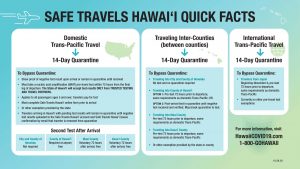New guidelines for trans-Pacific, interisland travel
Posted on Oct 28, 2020 in Capitol Connection, Featured
Go to Quick Facts at https://hawaiicovid19.com/travel/getting-to-hawaii for a summary of the different guidelines.
It’s taken a monumental effort by many, but the state’s launch of pre-travel — and in some cases post-travel — testing for travelers marks a milestone for Hawai‘i. While nothing is “foolproof” when it comes to COVID-19, Hawai‘i is doing more than every other state in the nation to protect public health for residents and visitors, say state officials. “The pre-travel testing program is just one part of our multi-layered system that we believe is making Hawai‘i once again a safe place to travel,” said Governor Ige at an Oct. 15 media briefing. “Today begins our single biggest effort since the start of the pandemic to revive our economy. We are asking for the same diligence and care from our visitors that we expect from our residents.”
The multi-layered program combines pre-travel testing involving “trusted travel partners” and a possible second layer of COVID-19 testing, depending on the island, for arriving passengers who aren’t going into quarantine. The pre-travel testing of passengers — both residents and visitors — age 5 and older 72 hours from the final leg of departure allows those with a negative result to avoid the state’s 14-day mandatory quarantine. Media reports from travelers who made the journey Oct. 15 said the pre-travel testing system was “really pretty easy,” as well as uploading information to the Safe Travels site. According to early reports, the majority of arriving passengers came into the state with their test results in hand. “To me that’s a great indication that the testing program is working,” said Department of Transportation spokesperson Tim Sakahara.
Starting Nov. 6, the pre-travel testing program will expand to Japan, where travelers from that country may bypass Hawai‘i’s mandatory 14-day quarantine if they take a COVID-19 test from a trusted testing partner in Japan. The test must be taken no earlier than 72 hours prior to departure and the test must be negative. For details, go to hawaiicovid19.com or https://www.allhawaii.jp/covid19/.
For travel within Hawai‘i, people can bypass quarantine for Kaua‘i, Maui and Hawai‘i counties by getting a pre-test 72 hours before departure. Hawai‘i island also offers a second option of a post-arrival test, but travelers must remain in quarantine until a negative test result is received. Only test results from trusted testing partners approved by the state Department of Health will be accepted. The growing lists for trans-Pacific and interisland pre-travel testing, including registration instructions and costs for both trans-Pacific and inter-county travel, can be found at https://hawaiicovid19.com/travel/faqs/. Visitors can also email [email protected] or call 1-800-GOHAWAII.
From the visitor industry side, John DeFries, CEO of the Hawai‘i Tourism Authority, said COVID-19 safety messages to visitors, including a “Kuleana Campaign” to teach about safety precautions and Hawai‘i’s cultural etiquette, is being widely promoted. “The visitors must exhibit a level of sensitivity and responsibility toward our people as they come to enjoy their vacation in the islands.” For the months ahead, DeFries spoke with feeling and concern about the “economic freefall” Hawai‘i finds itself in. He emphasized, “This is an imperfect scenario executed by imperfect people who have one thing in common: aloha for Hawai‘i. We need to hold onto that spirit. The cynicism has to stop. We’ve got to create a healthy attitude to support our leaders.”
